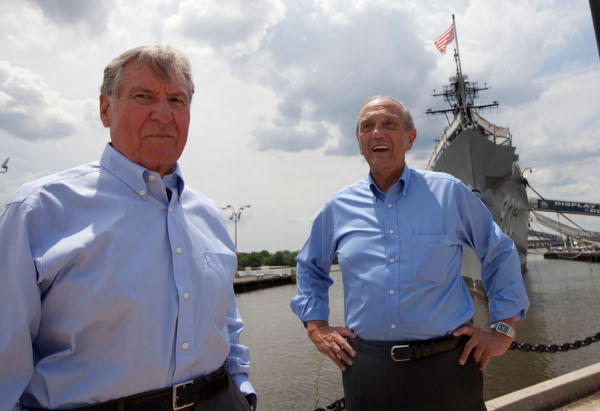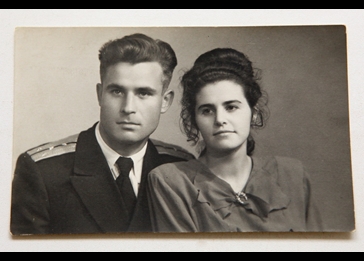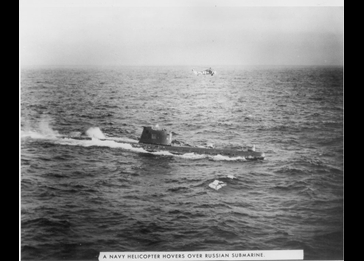
Fifty years ago this month, in October 1962, the world teetered on the brink of nuclear war. On October 22, 1962, after reviewing photographic evidence, President John F. Kennedy informed the world that the Soviet Union was building secret missile bases in Cuba, just 90 miles off the shores of Florida. For the next 13 days, the world held its breath as the Soviet Union and the United States confronted each other about missiles stationed in Cuba pointed at the United States, and missiles stationed in Turkey and Italy pointed at the Soviet Union. While politicians sought a resolution to the standoff, no one was aware of the events taking place inside the Soviet submarine B-59 in the waters off the coast of Florida.
To commemorate the 50th anniversary of the Cuban Missile Crisis, celebrated PBS show Secrets of the Dead chronicles how the actions of one man, during arguably the most dangerous moment of the Cold War, averted nuclear war. The Man Who Saved the World, premiering Tuesday, October 23 at 8 pm CT on NPT and PBS stations nationwide (check local listings), tells the unsung story of Soviet naval officer Vasili Arkhipov, second-in-command on submarine B-59, who refused to fire a nuclear missile and saved the world from World War III and nuclear disaster.
Nashville resident and award-winning author Gary Slaughter, a young naval communications officer on the USS Cony (DD-608), an anti-submarine warfare destroyer, remembers vividly the encounter with Soviet submarine B-59. His ship was part of an ASW task force including a squadron of destroyers and the USS Randolph, an ASW aircraft carrier. The task force was stationed on the Cuban Quarantine Line about 300 miles southwest of Bermuda. American ASW strategic intelligence had identified a number of Soviet submarines that were traveling southward toward Cuba in advance of the Soviet freighters carrying medium-range nuclear missiles and other arms for use by Fidel Castro’s forces positioned on the north coast of Cuba. On October 27 at about five o’clock in the afternoon, the Cony detected a sonar contact, which turned out to be the B-59, a Soviet Foxtrot class, diesel-battery powered submarine. Following the naval protocol for challenging unidentified submarines to surface, Cony crewmen dropped five practice depth charges.

The commanders of each Soviet submarine had permission to act without direct orders from Moscow if they believed they were under threat. Each of the four subs was carrying what the Soviets called a ‘special weapon’, a single nuclear torpedo, comparable in strength to the bomb dropped on Hiroshima. The torpedo could be fired only if the submarine captain and political officer were in agreement. Each had one half of a key which, when joined, unlocked the firing mechanism.
“For the first time in life a commander of a submarine had a nuclear weapon and had the authority to fire the missile at his command,” said Ryurik Ketov, who is interviewed in The Man Who Saved the World, and commanded one of the four subs.
However, aboard the B-59, three men—not two—needed to be in agreement. As commander of the entire submarine fleet, Arkhipov had the power to veto firing the nuclear-tipped torpedo and was one of the only men who knew about the mission in advance.
It took nearly five hours of unrelenting interrogation by the USS Cony before B-59 was on the surface. Fifty years later, The Man Who Saved the World recounts Arkhipov’s courageous story during those tense five hours and how, with a single act, he stopped the destruction of life as we know it.
Just how close the world came to an exchange of nuclear weapons was not revealed until the 2002 publication of Peter Huchthausen’s October Fury. Slaughter was the only Cony crew member whose story was told in the book. Since its publication, Slaughter has been approached by four documentary film makers seeking the participation of Slaughter and other Cony crew members in the making of a documentary to be aired on the 50th anniversary of the Cony-B-59 confrontation. He chose to work with Bedlam Productions, the team behind The Man Who Saved The World, for three reasons, he says.
“First, they were the first group to obtain credible Russian witnesses to tell the Soviet side of the story. Second, Bedlam had entered a partnership with PBS to ensure the story was fully aired in the United States. And finally they are well-known for producing one of my favorite movies, the 2010 Best Picture Oscar-Winner, The King’s Speech.
On the week before the NPT and PBS broadcast premiere of the documentary, and the anniversary of the October 27 incident, The NPT Media Update blog caught up with Slaughter to shed more light on that day and the issues raised in the documentary.
NPTMU: You kept your story about the interaction between the USS CONY and Soviet sub B-59 to yourself for 40 years. But am I right in assuming that neither you, nor anyone, knew there were atomic weapons on that sub? So while the country knew how close we had come to nuclear war in relation to the nuclear weapons in Turkey, Italy and Cuba, no one knew just how close when it came to those subs. What was it like to learn that ten years ago?
GS: Yes, for 40 years, I told no one, including my wife and family, about this incident. Until the 2002 publication of Peter Huchthausen’s October Fury, none of us aboard Cony was aware that B-59 was armed with a nuclear-tipped torpedo. While this revelation was indeed sobering, it wasn’t the only factor that made this incident a dangerous and potentially catastrophic situation.
Soon after we forced B-59 to the surface, out of the night sky, one of our land-based, fixed-wing Neptune P2V aircraft roared over the scene and dropped several small incendiary devices, presumably to activate his photoelectric camera lenses to photograph the submarine. The incendiaries sounded like a string of large firecrackers exploding. Bam! Bam! Bam! And the light flashes were absolutely blinding.
Understandably believing he was under attack, Vitali Savitsky, the submarine’s commanding officer, cleared his conning tower and wheeled his boat around, bringing his torpedo tubes to bear on Cony. Had he fired, even a conventional torpedo, military historians agree that the United States would have most likely launched an all-out nuclear attack on the Soviet Union, which would have responded in kind. Contributing to this conclusion, earlier in the day, one of our U-2 spy planes operating over Cuba was shot down by a Soviet surface-to-air missile.
The combination of these two dangerous incidents caused the Kennedy White House to refer to October 27, 1962, as Black Saturday, the most dangerous day in the history of our country — the day that nearly resulted in the destruction of the world.

What I found most fascinating in THE MAN WHO SAVED THE WORLD is that for the average citizen, when we think of nuclear war, there’s this tendency to think of leaders who might be slightly crazy with their finger on the button, and that no sane person would do that. But what almost happened had a lot to do with communication. The signal for surfacing was different then for the United States and the Soviets. So while the CONY was telling them to surface, they were misinterpreting and thinking they were being attacked. Did you have any idea then that that’s what was happening?
Of course, we had no way of knowing what was going through the mind of Savitsky. One can only assume that after hours of relentless hounding by Cony in a submarine on which conditions were nearly unfit for human life, he was exhausted and irrational, at best. This assessment is shared by those who witnessed his behavior at the time. Unfortunately he was solely empowered to launch the nuclear torpedo. Whether he allowed others to dissuade him from doing so or had a miraculous change of heart, no one knows for sure. There are conflicting opinions on this matter.
After ten years of researching the testimony of witnesses and the assessment of military scholars, I am suspicious of the Russian assertion that the slight difference in protocol for challenging a submarine to rise to the surface could have been reasonably sufficient to cause Savitsky to conclude that his submarine was being attacked.
There is another factor that contributes to my skepticism. In addition to dropping the five practice depth charges, using underwater communication equipment, Cony transmitted the International Code signal “I D K C A” meaning “Rise to the Surface.” Any experienced submarine commander, including Savitsky, would have been familiar with this protocol.
For years, I’ve believed this was a story conceived by former Soviet leaders to cover up their incompetence and the ill-conceived nature of this unfortunate mission, undertaken by four Foxtrot class diesel-electric submarines, including B-59, that didn’t stand a chance of eluding the formidable American anti-submarine forces deployed along the Quarantine Line.
I’m sure you couldn’t know then that the Soviet submariners on B-59 were not in contact with Moscow and were essentially in the dark. I found it fascinating as well, that their understanding of what was happening was coming from news reports they were pulling in. Did you then, and do you now, have an empathy with their plight?
As a former Communication Officer, it doesn’t surprise me that long-range radio communication between B-59 and Moscow was difficult at best. It was well-known back then that radio transmissions to and from ships operating in the Sargasso Sea were not reliable. However, from accounts I have read, for some reason, Moscow chose not to maintain radio contact with B-59. So it is logical that in a desperate desire to know what was happening in the world, B-59 tuned into news broadcasts from onshore American radio stations. B-59 crewmembers included six English-speaking interpreters who were trained to intercept U.S. naval communications. They would have no trouble understanding American newscasts.
At the time of this incident, the Soviet Union was the sworn enemy of the United States. As an American naval officer, I felt no empathy whatsoever for the B-59 crewmembers. As a professional anti-submarine warfare (ASW) specialist, I was trained to hunt and, if necessary, to kill Soviet submarines. We proudly created the “plight” that the B-59 officers and crew were forced to endure. That was our job.
History is the greatest teacher. What should the United States, and the world, take from this story? So much of the build-up and tension at the time seems to have come from fear and misunderstanding. Are we any better at cutting through that now?
At sunset on Black Saturday, in the White House situation room, Robert McNamara, Secretary of Defense, said to his friend and colleague, Dean Rusk, Secretary of State, that he wasn’t sure that the sun would rise the next morning.
Fortunately, before the next dawn, Kennedy and Khrushchev had reached an agreement that brought an end to the Cuban Missile Crisis. Part of this accord called for establishment of communication processes including the now famous Red Phone and treaties to control the escalation of the arms race by banning nuclear testing and limiting the proliferation of nuclear weapons. With these limits in place, the United States and the Soviet Union entered a period of détente held together by the ominous reality of mutually assured destruction.
Lastly, have you ever met the widow of Vasili Arkhipov (“The Man Who Saved the World”), or any of those surviving Soviet Mariners?
I have not met any of the B-59 crewmembers in person, but I feel that I know them very well. Earlier you asked if I empathized with their plight. In 1962, I most certainly did not. But after recently learning what happened to these officers and men upon their return from this mission, I must admit that I now feel sympathy toward them and their families.
First of all, as I said earlier, they were given an impossible mission and were equipped with substandard means by which to fulfill that mission. Given the powerful forces arrayed against them, they had no hope of succeeding. When they returned to their homeport in Russia, they were informed by the admiral in charge of the mission that it would have been preferable if they had “gone down with their ships.”
The filmmakers who travelled to Moscow to interview survivors of these men were appalled by the squalor in which the widow of the “Man Who Saved the World” was forced to live. The physical appearance of Captain Ketov, the once proud commanding officer of the B-4 submarine, was pathetic.
They deserved better.
How’d you wind up in Nashville?
A. My wife Joanne and I moved here in from Naples, Florida in 1998. Over the course of my professional career I became an expert on the management of corporate information technology organizations. I traveled all over the globe consulting to large corporate clients. One of my clients, Johnson & Johnson, asked me to assist them in starting a new business here in Nashville. They knew that I had founded a number of IT businesses in my career and they retained me to help them get started.
Neither Joanne nor I had ever been to Nashville. Much to our surprise, we fell in love with the area and decided to move here. Instead of continuing my IT consulting business, I tried my hand at writing fiction. Over the past dozen years, I have written five, 400-page novels, which have garnered a total of nine book awards. The novels are set on the World War II home front during the last five seasons of the war. They include Cottonwood Summer, Cottonwood Fall, Cottonwood Winter: A Christmas Story, Cottonwood Spring, and finally Cottonwood Summer ’45, which is set here in Nashville.
8 Comments
The USS Cony (on which I served from 1965 to 1967) is DD 508, not DD 608.
Hi there,
Were you out of Boca Chica? I lived at mm100 during 1965…KeyLargo, Upper Fla Keys with Civil Defense gear and air raid siren…Ben’s Standard Service…
[…] submarines and the officer who prevented the firing of a nuclear torpedo, Vasili Arkhipoy. Click HERE for complete details. A second good story about the Soviet sub, BG-59 can be read by clicking […]
I’ve always had a grim interest in the Cuban missile crisis, but after watching this episode, it made the interest even more intense. It’s a terrifying thought that the fate of a world can rest on the decision of one man, and I truly think Vasili should have been given the highest award for bravery in Russia and the Nobel Peace Prize for what he did.
Another dark moment in our planets insane nuclear history is Able Archer 83, and I would love to see PBS do a program about it… Yet another time where this planet cam dangerously close to full out nuclear holocaust, but stepped away from the brink, only to show it several weeks later on ABCs “The Day After”!!
I do consider all of the ideas you have presented in
your post. They’re really convincing and will definitely work. Nonetheless, the posts are too quick for newbies. May just you please extend them a little from next time? Thanks for the post.
Seeing the location of his grave gives me pause. He, Vasili Arkhipov, deserves to be interred in the Kremlin Wall, along with others who were considered heroes, such as Sergei Korolev, who was the father of the Soviet space program. Only then can Americans who travel to Moscow and who understand the importance of saving us ALL from nuclear annihilation, could pay appropriate tribute to one so brave.
Hail and thanks Mr Vasili
I m from Holland
The whole world would have been ashed
with thousands of Nagasakis
and now again
see my song
google
ankhaton+jesus+climate
I think Mr Slaughter that McNamara then had destroyed the world
not your ship s commander
who probably just followed McN orders
Actually we have the same danger
with Israel
They have 4 submarins nuclear tipped
These captains seem to have strange orders
in case something destructif happens to the country
THIS SHOULD BE A CONSIDERATION
with all nuclear negotiations all over the planet
also
this should be discussed with the AIPAC
because the planet would totally be destroyd
Please nsa nsa “nsa” take a note here !
Please read/listen
google
BARACK OBAMA SYMPHONY